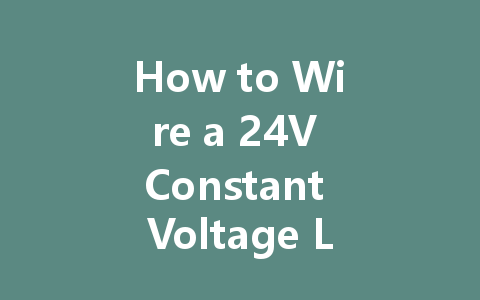Wiring a 24V constant voltage LED driver can be a straightforward task when you have the right information at hand. Whether you are upgrading your lighting system or setting up a new project, this guide will walk you through the essential steps involved in wiring your LED driver safely and effectively.
정전압 LED 드라이버의 이해
Before diving into the wiring process, it’s crucial to understand what a constant voltage LED driver is and how it functions. A 24V constant voltage LED driver supplies a consistent voltage to your LED lighting system, ensuring that the lights operate at their optimal level. These drivers are typically used in applications where a specific voltage must be maintained, such as LED strips, panels, or other compatible fixtures.
Tools and Materials Needed
To successfully wire your 24V constant voltage LED driver, you will need a few tools and materials:
Make sure to gather all your tools and materials before you begin, as this will streamline the process and reduce delays.
Safety First: Precautions to Take
As with any electrical project, safety should be your top priority. Here are some precautions to keep in mind:
Step-by-Step Wiring Process
Begin by unpacking your LED driver and lights. Check for any visible damage and ensure you have all necessary components. Review the specifications provided by the manufacturer to understand the input and output wiring.
Locate the input and output wiring terminals on the LED driver. Typically, the input side will connect to the power source, while the output side connects to the LED lights. Most drivers will have clearly marked ‘+’ (positive) and ‘–’ (negative) terminals.
Using wire cutters, trim the input wires to the desired length and strip the ends. Connect the input wires from your power source to the corresponding terminals on the LED driver. Make sure to match the positive wire to the ‘+’ terminal and the negative wire to the ‘–’ terminal. Secure the connections using either electrical tape or wire connectors.
Next, you will repeat the same process for the output wires. Strip the ends of the output wires and connect them to your LED lights. Again, ensure that the positive wire is connected to the ‘+’ terminal and the negative wire to the ‘–’ terminal. Double-check your connections to prevent polarity issues that could damage the lights.
After all wires are connected, make sure to utilize electrical tape or wire connectors to secure any exposed wire ends. This step is crucial to ensuring a safe installation that minimizes the chance of short circuits.
Testing Your Installation
With all connections secured and insulated, you can now turn the power back on. Watch for any signs of malfunctioning, such as flickering lights or odd noises.
To ensure that your LED driver is functioning properly, use a multimeter to test the output voltage. Set the multimeter to the DC voltage setting and connect the probes to the output terminals. Verify that the reading is around 24V, indicating that the driver is working correctly.
Troubleshooting Common Issues
If you encounter problems:
결론
Wiring a 24V constant voltage LED driver is a manageable project with the right tools and knowledge. By following this guide, you can appreciate the benefits of enhanced lighting solutions, whether for home or business applications. With proper wiring and safety measures, your LED lights will shine brightly and efficiently, providing you with lasting illumination.
